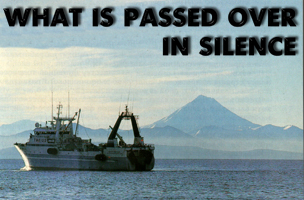 |
REGIONAL INFORMATION DIGESTECONOMY, ECOLOGY, HISTORY, CULTURE |
# 1, 1996

Lidia EGINA
The major science cooperator in Kamchatka Institute of Ecology and Nature Management. She is living in Kamchatka since 1966. Lidia Egina completed Institute of Economy and Finances of Rostov-na-Donu. She has been working in the sphere of fishery industry for more than 5 years
Soviet «five-year plans» sank into oblivion. Twelve of them is a 60-year life of the vast country. Actually it is life and destiny of one generation. Since the beginning of time people have been afraid of Devil’s dozen, and not without reason, strange as it may seem. The 13-th five-year plan turned out to be a Devil's dozen as well.
It was the period from 1991 to 1995. Guidelines and goals of economic and social development are still fresh in mind as well as priorities of various state programs. Rate, increase, per cent... right up to 2010.
Daring reigns in Russian nature: if something is done, it is done mightily. Actually nothing of planned economy is left, predictions are at macro level, reality is at micro level.
And what we do have instead of 5-year plans, annual plans and daily plans? Let us have a look at macro level. First of all it is the President’s Appeal. It contains brief description of main goals and tasks, difficulties of the transitional period, mistakes and calls. True, this year the text of the Appeal was enriched by punitive measures. Then come regional and federal programs worked out by the government and subject to governmental approval. And finally, the Budget, which actually is an annual plan, containing the prognosis of social economic development necessary to proof of debit and credit.
Without any monitoring it is clear that situation in the regions like Kamchatka is absolutely critical. Which is caused by geographical and and economical conditions. Costs of production as well as of territory recovery works remain to be extremely high which results in very low development of processing industry and limits the range of auxiliary productions and services. Due to "miscalculation" of the Ministry of Finance, Kamchtka instead of being considered as a subsidized region is now considered as a donor region. And now it is going to get "financial support" as provided by the Regulation dealing with Regional Investment Programs which means that it is not easy to succeed in obtaining the money... As the result of this, people in Kamchatka literally get cold in their "concrete boxes" as there are no funds to pay for fuel. But hot and abundant Stavropolje (the region in the south of Russia) all of a sudden turned out to be a subsidized region!
Life is hard for elderly people. And there are quite a lot of them: over 71 thousand, 17% of the population. And number grows every year. On April 1, 1996 average amount of a pension was 408 thousand roubles, which made 26,5 % of average wages and a little more than 50% of living minimum. With public utilities costs deducted, it is difficult to imagine how old people manage to survive. This results in growing number of deaths. In the first three months of 1996 this number is 8% higher than it was in 1995...
And working people devided into two groups suspiciously looking at each other: a small group flies on the sly for holiday to Canary Islands and other blessed places, and the major group is kept waiting to get wages, pensions, grants. And criminality grows, including economic crimes. There seem to be no company with correctly organized accounting. This is especially true with newly established legal entities. And in most cases they simply get lost in the labyrinth of current laws. As a result of this the collected taxes make only half of the expected amount. Economic development in 1995--1996 leaves very much to be desired as well as collection of taxes. Which means that all financing coming from the budget will not be sufficient at all levels, including social payments. And "pre-election injections" made situation even worse. This situation is going to be very difficult for industrial structures. Only the most flexible and adaptable will be able to survive under unfavourable conditions of industry and market depression.